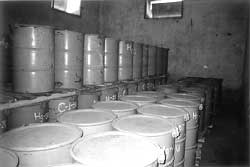Failed Trojan horse
 the Trojan horse myth is all about deceit, stealth and camouflaging. If only the Trojan soldiers knew who was inside, the ancient tale would have ended differently. Centuries have passed, but the problem of the Trojan horse still endures. Soldiers hidden inside the wooden structure, over time, have given way to potentially more lethal gases and germs. The technique, too, has acquired a new identity: biochemical warfare. Military personnel checking sealed containers suspected of carrying deadly toxins have absolutely no way of knowing exactly what is inside. Tricky situation, this. And also very dangerous.
the Trojan horse myth is all about deceit, stealth and camouflaging. If only the Trojan soldiers knew who was inside, the ancient tale would have ended differently. Centuries have passed, but the problem of the Trojan horse still endures. Soldiers hidden inside the wooden structure, over time, have given way to potentially more lethal gases and germs. The technique, too, has acquired a new identity: biochemical warfare. Military personnel checking sealed containers suspected of carrying deadly toxins have absolutely no way of knowing exactly what is inside. Tricky situation, this. And also very dangerous.
Now, us researchers at the Los Alamos National Laboratory ( lanl ) in New Mexico say an ingenious drill bit could help those who frequently find themselves in such situations. lanl 's sampling bit can extract a specimen of the liquid, gas or powder and then seal the container safely in seconds. This could be promising low-risk, cheap and portable technique for inspecting suspect biological and chemical weapons, or unlabelled old drums from heavy industry. Right now, the only safe way to verify the contents of a sealed container is to scan it with a portable isotopic neutron spectroscope or pins system. It works fine, but the only restriction, and a very big one at that, is its price. Each comes for about us $120,000.
Roger Johnston, one of the developers of the drill, says the new us $400 device fits into any standard electric drill. The bit is completely contained within the tool and has a silicone cap that temporarily seals the drilled area as the operator applies pressure during drilling. Once the hollow drill bit has penetrated the container wall, it retracts within its housing and pierces a "vacutainer'
